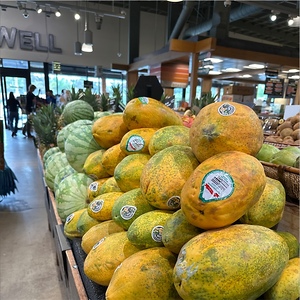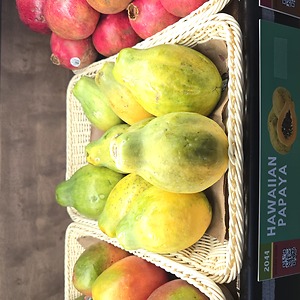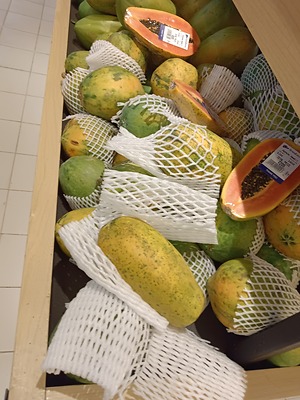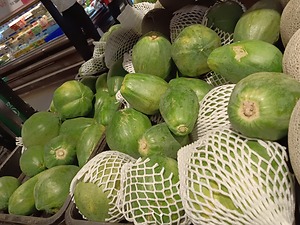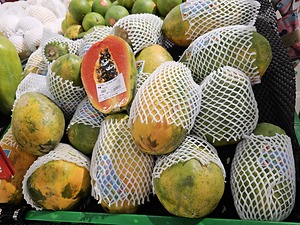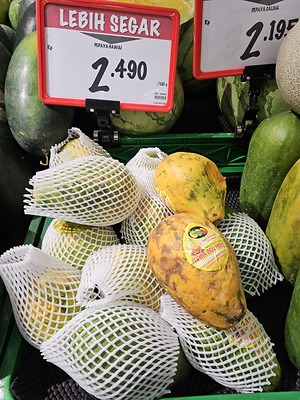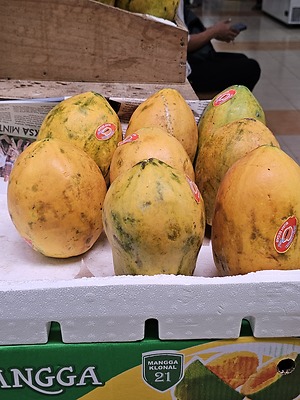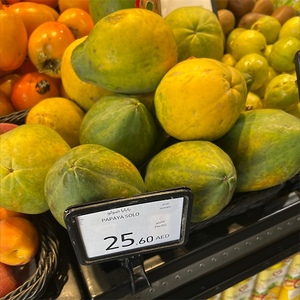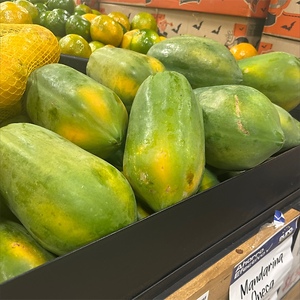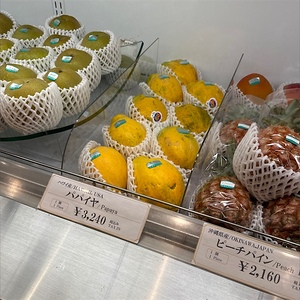

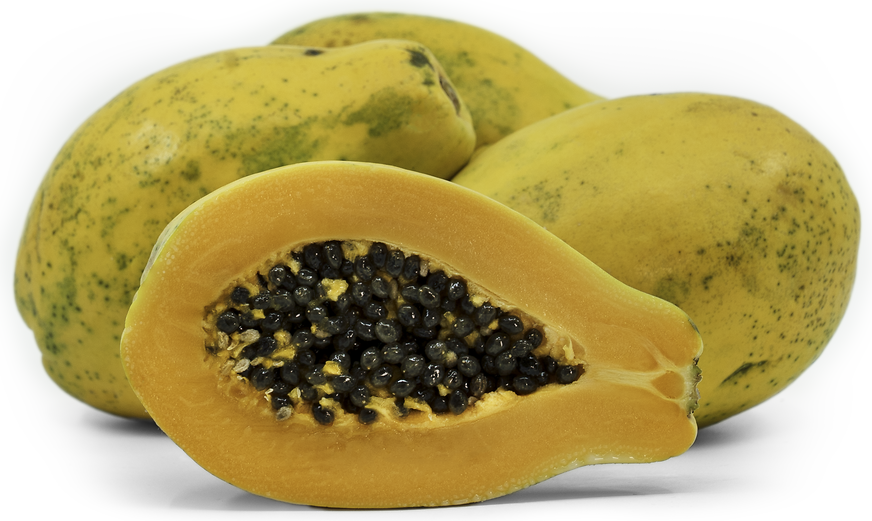
Hawaiian Papaya
Estimated Inventory, 10 ct : 7.00
This item was last sold on : 07/24/25
Description/Taste
Hawaiian papayas are a grouping of multiple varieties of papayas that are typically smaller in size and average up to one pound in weight. The oblong to pear-shaped fruits have smooth, semi-thick, and inedible skin that matures from green to shades of yellow-green when ripe, softening slightly in texture. Underneath the surface, the flesh ranges in color from bright yellow, orange to pink, depending on the variety, and is tender, aqueous, and smooth, encasing a central cavity filled with oval, black-brown seeds. The seeds are covered in a gelatinous coating and are edible, bearing a sharp, pepper-like flavor with a crunchy consistency. Hawaiian papayas are aromatic and have a mild, sweet, and fruity taste with delicate notes of peaches and melon.
Seasons/Availability
Hawaiian papayas are available year-round.
Current Facts
Hawaiian papayas are botanically a part of the Carica genus and are tropical, aromatic fruits belonging to the Caricaceae family. The name Hawaiian papaya is a general descriptor used to encompass several papaya varieties grown throughout the Hawaiian Islands, including Rainbow, Kapoho Solo, Kamiya, also known as Laie Gold, and Sunrise, sometimes known as SunUp or Strawberry papaya. Hawaiian papayas are extensively cultivated on the islands and are shipped to the mainland United States, where they supply a large portion of the papayas sold in grocery stores and supermarkets and are also exported worldwide to other countries. The brightly colored, sweet fruits are globally known for their individual serving size, much smaller in comparison to the larger Mexican papayas, and the Hawaiian varieties are also favored for their honeyed flesh and tender texture.
Nutritional Value
Hawaiian papayas are an excellent source of vitamin C, an antioxidant that reduces inflammation while boosting the immune system and provides high amounts of vitamin E, a nutrient shown to protect the body against free radical damage. The fruits are also a good source of fiber to regulate the digestive tract, potassium to balance fluid levels, vitamin A to protect against vision loss, and contain lower amounts of vitamins B and E, calcium, and iron. In addition to vitamins and minerals, Hawaiian papayas contain chymopapain and papain, protein-digesting enzymes that stimulate the digestive tract.
Applications
Hawaiian papayas are best suited for fresh applications, as their sweet, fruity flesh is showcased when consumed straight, out-of-hand. The fruits can be sliced in half and eaten raw, discarding the inedible skin, or the halves can be used as an edible bowl, topped with fillings, dips, desserts, or salads. Hawaiian papayas can also be blended into juices, fruit punch, and smoothies, chopped and tossed into green salads, salsas, and ceviche, pureed and frozen into popsicles, or mixed into soups and grain bowls. The sweet flesh often lacks acidity and is enhanced by a squeeze of lime juice, baked or grilled for added flavor. The flesh can also be incorporated into desserts such as cakes, mousses, ice cream, and crème brulee. It is important to note that the seeds of Hawaiian papayas are edible and contain a peppery flavor. The seeds can be eaten raw, but they are preferably blended into salad dressings, sauces, and smoothies. Hawaiian papayas pair well with cottage cheese, fruits such as pineapple, mango, lime, and coconut, nuts such as macadamia and almonds, tomatoes, avocados, cucumbers, seafood such as crab, shrimp, and fish, meats such as poultry and pork, and aromatics, including cilantro, cinnamon, cloves, nutmeg, mint, and rosemary. Whole Hawaiian papayas should be kept at room temperature to ripen, and once the skin color transitions into a variegated blend of green and yellow, the fruits can be stored in the refrigerator for a couple of weeks.
Ethnic/Cultural Info
Rainbow papayas are one of the main varieties sold under the Hawaiian papaya name and are commercially grown for export. The genetically modified variety was created by scientists in response to the damaging ringspot virus. Genetically modified fruits have remained a point of contention within the produce industry, but Rainbow papayas are often viewed among islanders as a variety that saved the Hawaiian papaya industry. In the mid to late 20th century, the ringspot virus spread across the islands, considered one of the most destructive diseases to papayas, and had almost destroyed Hawaii’s $17 million dollar industry. In response to the devastation, scientists and researchers from the University of Hawaii and Cornell University joined forces in 1984 to genetically research virus resistance. Through multiple years of tests and experiments, a new variety of papaya was created in 1998 that could be inoculated with genetic material resistant to the ringspot virus, much like humans getting a flu shot. The new papayas were quickly approved and deemed safe through the United States government for release under the name Rainbow, and seeds of the newly improved Rainbow variety were freely given to struggling papaya growers. Rainbow papayas proved to be highly resistant to the ringspot virus, reinvigorating the Hawaiian papaya industry in just under four years after its release. In the modern-day, Rainbow papayas are highly valued for their flavor and historical significance. Many papaya farmers attribute their lasting careers to the creation of Rainbow papayas, and the fruits are seen as a healthy, nutritious superfood in commercial markets worldwide.
Geography/History
Papayas are believed to be native to tropical regions of the Americas, specifically the lowlands of eastern Central America, and have been growing wild for thousands of years. The ancient fruits were consumed as a source of nutrition by many different peoples and tribes, and when Portuguese and Spanish explorers arrived in the New World, they too began eating papaya, bringing the fruits with them on voyages. Papayas were introduced to the Hawaiian Islands sometime around the 1820s, but the fruits weren’t officially recognized until the early 20th century. In 1911, botanist Dr. Gerritt P. Wilder brought papaya seeds back from a trip to Barbados and planted the seeds, producing the first fruits known under the Solo varietal name in 1919. Solo papayas were the only commercially grown variety in Hawaii, but over time new varieties were created, and the smaller, individually sized fruits became an important export for the islands under the name Hawaiian papayas. The Hawaiian papaya industry continued to thrive until the deadly ringspot virus was discovered on the island of Oahu in the early 1950s. The virus quickly traveled across the islands, and in the 1990s, the virus had decimated almost all of the papaya production within the islands. To save the dying industry, scientists and breeders developed two genetically modified papayas resistant to the ringspot virus and introduced these varieties into commercial production. Today there are multiple varieties grown under the Hawaiian papaya name sold locally at fresh markets and exported to the mainland United States. The fruits are also sold internationally to Canada, Germany, and Japan.
Featured Restaurants
Restaurants currently purchasing this product as an ingredient for their menu.
| Asti Ristorante | San Diego CA | 619-232-8844 |
| La Jolla Beach & Tennis Club | San Diego CA | 619-816-8319 |
| Shoreside Support Boat | San Diego CA | 704-277-7929 |
| San Diego Yacht Club | San Diego CA | 619-758-6334 |
| Blue Water Seafood Market and Grill | San Diego CA | 619-497-0914 |
| C 2 C | San Diego CA | 619-972-9345 |
| Kona Kai Resort and Marina | San Diego CA | 619-221-8000 |
| GoodOnYa | Encinitas CA | 949-295-3145 |
| Pamplemousse Grill | Solana Beach CA | 858-792-9090 |
| Beach Terrance Inn | Carlsbad CA | 760-729-5951 |
| The Taco Stand | San Diego CA | 619-549-9919 |
| US Grant Hotel Grill | San Diego CA | 619-232-3121 |
| Lodge at Torrey Pines Main | San Diego CA | 858-453-4420 |
| The Glen at Scripps Ranch | San Diego CA | 858-444-8500 |
| Juniper & Ivy | San Diego CA | 858-481-3666 |
| Coco Maya by Miss Bs | San Diego CA | 858-245-3780 |
| The Santaluz Club Inc - Banquet | San Diego CA | 858-759-3150 |
Recipe Ideas
Recipes that include Hawaiian Papaya. One



